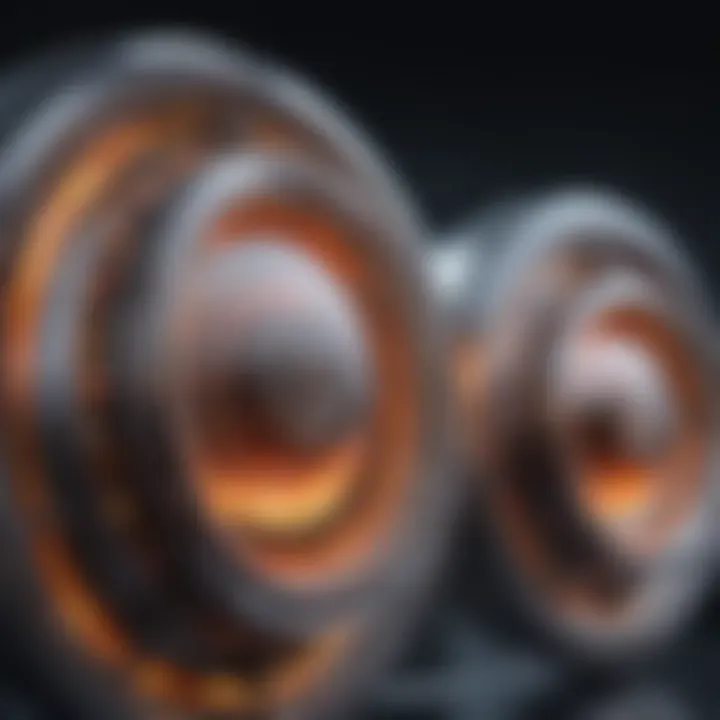Innovative Body Cooling Devices: Mechanisms & Uses


Intro
The exploration of body cooling devices has seen significant advancements in recent years. With an emphasis on the mechanisms that underlie their functioning, these devices cater to a variety of applications, from health management to performance enhancement. Understanding the intricacies of these technologies is essential for professionals and researchers alike. The interplay between human physiology and these cooling devices plays a vital role in optimizing performance across different fields.
Research Overview
Methodological Approaches
Research into body cooling devices employs various methodologies. Experimental studies often assess the effectiveness of different cooling techniques in real-world scenarios. Clinical trials are critical in understanding how these devices aid in temperature regulation, particularly in medical settings. Observational studies, on the other hand, provide insights into how athletes or individuals with specific health conditions benefit from cooling technologies.
A multi-disciplinary approach is evident, where collaboration across fields like engineering, medicine, and sports science is prominent. It leads to a comprehensive understanding of not just the mechanics of the devices but also their impacts on human health and performance.
Significance and Implications
The implications of advancements in body cooling devices extend beyond mere comfort. They have the potential to enhance athletic performance, improve recovery times, and even play a role in lifesaving medical interventions. By effectively managing body temperature, these devices can mitigate the risk of heat-related illnesses and contribute to better outcomes during physical exertion. Understanding the significance of these advancements offers insights into future research directions and practical applications in various industries.
Current Trends in Science
Innovative Techniques and Tools
Recent innovations have led to the development of various cooling techniques. These include evaporative cooling, phase change materials, and advanced thermoelectric devices. Each of these techniques presents distinct advantages. For instance, evaporative cooling can be both efficient and cost-effective. In contrast, phase change materials provide sustained cooling effects, beneficial for prolonged activities.
Research continuously leads to new tools that enhance the effectiveness of body cooling. Wearable technology, such as cooling vests and smart textiles, integrates cutting-edge materials that adapt to the user's body temperature. These innovations help maintain performance and health through optimized thermal regulation.
Interdisciplinary Connections
The realm of body cooling devices does not exist in isolation. It intersects with various fields such as physiology, engineering, and sports medicine. This interdisciplinary nature facilitates a deeper understanding of how body cooling impacts physiological responses. For instance, by integrating insights from biomechanics and thermoregulation, researchers can design devices aimed at specific user needs whether they are elite athletes or individuals suffering from heat sensitivity.
The advancements in body cooling devices represent a crucial step in enhancing human performance and health, showcasing the importance of interdisciplinary approaches in research.
As we continue to develop more sophisticated body cooling technologies, the implications for industry practices and health outcomes will likely expand, presenting new opportunities for exploration and application. This ongoing evolution reflects the dynamic nature of both science and technology.
Prologue to Body Cooling Devices
The discussion about body cooling devices is vital in our understanding of human physiology and the effects of temperature regulation. These devices serve not only as innovative solutions to combat extreme heat but also play a significant role in various sectors such as healthcare and sports. Exploring these devices can reveal their usefulness, elucidate the science behind their operation, and highlight their key applications.
Definition and Purpose
Body cooling devices are engineered tools designed to lower a person's body temperature. They find numerous applications in both medical and non-medical settings. The primary purpose is to maintain optimal body temperature to prevent overheating. This is particularly critical for athletes who exert themselves in high temperatures and patients experiencing fever or heat-related illnesses. Body cooling devices enhance performance and contribute to recuperation post-exercise. By actively managing thermal stress, they can protect individuals from heat-induced complications.
Historical Development
The history surrounding body cooling devices is quite rich and reveals the evolution of thermal management technologies. Early methods were rudimentary, involving simple techniques like wet cloths and ice packs. Over time, advancements in materials and engineering led to the development of more effective solutions. The advent of modern cooling technologies, including air-conditioned environments and wearable cooling vests, significantly improved human comfort and health. Recent innovations incorporate smart technologies that adjust cooling levels based on environmental changes, highlighting the progression from static solutions to dynamic systems.
From the basic techniques of the past to today's sophisticated cooling technologies, the journey illustrates a remarkable progression in our ability to manage body temperature effectively.
The Science of Body Temperature Regulation
The regulation of body temperature is a fundamental aspect of human physiology. It involves complex mechanisms that maintain thermal balance, essential for proper organ function and overall health. Understanding this science is crucial for the effective design of body cooling devices and their application across various fields.
Physiological Mechanisms
Body temperature regulation is primarily governed by the hypothalamus, a part of the brain that acts as a thermostat. It receives input from temperature receptors located throughout the body. When the body's temperature deviates from the normal range, the hypothalamus initiates responses to either generate heat or promote heat loss. For example, if the body temperature rises, mechanisms such as sweating and increased blood flow to the skin help dissipate heat. Conversely, shivering and reduced blood flow are activated to conserve heat when temperatures drop.
These physiological responses are critical in preventing hyperthermia or hypothermia, conditions that can lead to serious health issues.
Effects of Heat Stress
Heat stress occurs when the body's cooling mechanisms are overwhelmed. This can happen in high environmental temperatures or with exertion in a hot environment. Symptoms may include dizziness, excessive sweating, and fatigue. In serious cases, heat stress can cause heat exhaustion or heat stroke, which are life-threatening conditions.
The physiological effects of heat stress impact not only individual health but also performance in both athletic and occupational settings. Adequate body cooling devices can significantly alleviate these issues, allowing for a safer and more efficient performance.
Importance of Thermal Balance
Maintaining thermal balance is imperative for physical and mental well-being. When the body is in thermal equilibrium, metabolic processes operate efficiently, enhancing performance and reducing the risk of heat-related illnesses. For athletes, optimal thermal balance can lead to improved endurance and faster recovery times.
Thermal balance is also important in medical settings. For instance, during surgeries, maintaining the patient's core temperature is vital to prevent complications. Body cooling devices can aid in achieving and sustaining this balance, thus contributing to better health outcomes.


To summarize, the science of body temperature regulation serves as a foundational understanding behind advancements in body cooling devices. A thorough comprehension of physiological mechanisms, the effects of heat stress, and the significance of thermal balance guides the innovations in this field.
Types of Body Cooling Devices
Understanding the various types of body cooling devices is essential for grasping their applications in different fields. They play a crucial role in maintaining thermal comfort and enhancing performance, particularly in settings like healthcare and sports. Each type of cooling device presents unique benefits and considerations.
Active Cooling Devices
Active cooling devices utilize external mechanisms to reduce body temperature. They usually work by employing refrigeration technology or electronic cooling elements. These devices are especially beneficial in high heat environments, such as industrial areas or during intense exercise.
Benefits include:
- Rapid cooling effect, which can lower body temperature quickly.
- Adjustable settings for personalized cooling based on individual needs.
Examples consist of:
- Phase Change Materials: These absorb heat as they change states, effectively cooling the body.
- Air Cooling Systems: Devices that blow cooled air on the individual.
Passive Cooling Devices
Passive cooling devices rely on the principles of thermodynamics without using active energy sources. These devices typically enhance natural heat dissipation from the body.
Advantages:
- Lower energy consumption compared to active devices.
- Lightweight and often more comfortable to wear.
Common types are:
- Reflective Fabrics: Materials that reflect sunlight and heat.
- Cooling Gel Packs: These can be frozen and kept in contact with the body to provide relief.
Wearable Technologies
Wearable technologies represent a significant advancement in the cooling device landscape. They can integrate smart technology for monitoring and adjusting according to the user's environment or physiological data.
Key aspects to consider:
- Real-Time Monitoring: Many devices track body temperature, heart rate, and even perspiration to optimize cooling.
- User Customization: Wearers can often set preferences, making these devices adaptable to their specific needs.
Examples include smart bands or clothing equipped with sensors.
Cooling Vests and Garments
Cooling vests and garments are a practical application specifically designed for prolonged use. These garments are often worn under regular clothing in extreme conditions. The structure includes built-in cooling mechanisms or materials that draw heat away from the body.
Advantages of using these garments:
- Increased mobility features allow wearers to function effectively.
- Often lightweight and designed for comfort during extensive wear.
For professionals working outdoors, these garments help in meeting occupational safety and health regulations.
"Cooling technology not only enhances performance but also significantly reduces the risk of heat-related injuries in various industries."
Mechanisms of Action
Understanding the mechanisms of action in body cooling devices is vital for comprehending how these technologies function and their effectiveness in various applications. The underlying principles dictate how heat is transferred away from the body, which can significantly affect thermal comfort, performance, and even health in circumstances of heat stress. These mechanisms offer insights into the design considerations for maximizing cooling efficiency and ensuring user satisfaction.
Heat Exchange Principles
Heat exchange principles form the foundational concepts behind body cooling technologies. They consist of mathematical and physical laws that govern how heat is moved from one substance to another. The two primary forms of heat transfer are convection and conduction.
- Convection occurs when heat is transferred through air or liquid movement. For instance, fans or water-cooled garments use this principle, enhancing airflow around the user to remove heat effectively.
- Conduction involves direct heat transfer through materials, which is utilized in cooling vests that employ materials with high thermal conductivity.
The efficacy of these devices largely depends on optimizing these methods to achieve maximum cooling capacity. Factors such as temperature differential, humidity, and airflow all play significant roles in determining how effectively heat can be dissipated from the skin's surface to the environment.
Evaporative Cooling Techniques
Evaporative cooling techniques leverage the heat loss that occurs when water evaporates. As moisture evaporates from the skin or specially designed materials, it absorbs heat from the body, resulting in a cooling sensation. This method is particularly effective in environments with low humidity.
Some common applications of evaporative cooling include:


- Wearable cooling garments that contain moisture-absorbing materials to enhance the cooling effect.
- Cooling towels soaked in water that can be applied directly to the skin, providing immediate relief in high temperatures.
- Portable evaporative coolers designed to create a sustained cooling environment in various settings.
The effectiveness of evaporative cooling can be influenced by environmental factors, especially humidity. In high humidity conditions, the rate of evaporation decreases, limiting the cooling effect. Therefore, understanding the local climate is crucial in designing effective evaporative cooling systems.
Conduction and Convection Methods
Both conduction and convection methods can be employed simultaneously in advanced body cooling devices to enhance their cooling potential.
- Conductive cooling involves direct contact with materials that absorb and transfer heat efficiently. Materials like graphite or specialized polymers can draw heat away from the skin, utilizing the temperature differences.
- Convective cooling systems may involve fans or airflow channels designed to circulate air around the body or through garments, facilitating a continuous heat exchange cycle.
The combination of these two methods can provide more balanced thermoregulation, vital for athletes and individuals exposed to extreme heat.
"Integrating conduction and convection methods allows for a holistic approach in body temperature management, enhancing performance and comfort across various applications."
Such multi-faceted systems are becoming increasingly relevant for sports performance, outdoor activities, and occupational safety, where heat stress is a concern. Understanding how to balance these methods enhances the progress in body cooling technology.
Applications in Healthcare
The integration of body cooling devices in healthcare is a significant development. These devices play critical roles in various medical applications, enhancing patient care through innovative cooling methods. The benefits include improved recovery times, effective management of heat-related illnesses, and precision during surgical procedures. Understanding these applications offers insight into how technology can directly impact health outcomes and patient comfort.
Post-Exercise Recovery
Body cooling devices are crucial in post-exercise recovery, especially for athletes. After intense physical activity, the body can overheat, affecting performance and recovery times. Effective cooling is essential to restore optimal body temperature and minimize muscle fatigue.
- Rehydration: Cooling methods can help enhance rehydration by reducing core body temperature. This process encourages blood flow to the muscles affected during exercise.
- Reduction of Muscle Soreness: Many studies indicate that cooling can significantly reduce delayed onset muscle soreness. Athletes often report quicker recovery with controlled body cooling.
- Improved Performance: Regular use of cooling devices post-exercise can also improve performance in subsequent workouts. This leads athletes to adopt effective cooling strategies as part of their training regimens.
Management of Heat-Related Illnesses
Heat-related illnesses present a serious risk, particularly in environments with high temperatures or for individuals working in strenuous conditions. Body cooling devices are effective in managing conditions such as heat exhaustion and heat stroke.
- Preventive Measures: Devices can provide continuous cooling, helping to prevent heat stress before it happens. This is especially relevant in occupations such as construction or outdoor sports.
- Rapid Cooling: In emergency situations, cooling devices can rapidly bring down elevated body temperatures. This response is critical in preventing more severe complications from heat-related conditions.
- Improving Survival Rates: Studies have shown that the timely use of cooling technologies can significantly enhance survival rates in patients suffering from heat-related illnesses. Rapid intervention can also limit long-term health consequences.
Surgical Applications
The use of cooling devices extends into surgical environments, where temperature management is crucial.
- Thermoregulation: Maintaining patient body temperature during surgery reduces complications related to hypothermia or hyperthermia. Cooling devices ensure that patients remain within a safe temperature range.
- Enhanced Surgical Precision: In specific procedures, cooling tissues can make them less prone to damage. This is particularly useful in surgeries involving delicate organs or tissues.
- Shortened Recovery Time: Patients who benefit from thermal regulation during surgery often experience reduced recovery times. Optimized cooling can lead to fewer complications and a more comfortable experience post-operation.
Applications in Sports Performance
The significance of body cooling devices in sports performance cannot be overstated. As athletes push their physical limits, maintaining optimal body temperature becomes crucial for enhancing performance and ensuring safety. Application of cooling technologies allows for better performance under various environmental conditions, particularly in heat-dominated settings. Here we explore how these devices are reshaping athletes' training and competition.
Enhancing Endurance
One of the primary benefits of body cooling devices is their role in enhancing endurance during physical activities. When athletes are subjected to prolonged periods of exertion, their core temperature rises. Elevated body temperature can lead to premature fatigue and reduced performance.
Advanced cooling devices, such as exercise vests embedded with cooling gels or evaporative cooling systems, allow athletes to maintain a stable temperature. Research has shown that using these cooling methods prior to and during exercise can improve endurance performance significantly. Training sessions that integrate these cooling solutions enable athletes to maintain a higher level of intensity for longer periods.
- Cooling Vests: These garments circulate cool water or are infused with coolants, drastically reducing body temperature.
- Ice Packs: Targeted application of ice packs on pulse points helps stave off overheating.
Such technology is not limited to elite athletes alone. Recreational athletes can also benefit from the increased endurance provided by efficient body cooling devices. This leads to improved performance metrics and a more enjoyable training experience.
Preventing Heat-Induced Fatigue
In addition to enhancing endurance, cooling devices are paramount in mitigating the risks associated with heat-induced fatigue. Working out in high temperatures can quickly lead to excessive sweat loss and dehydration, resulting in dangerous conditions such as heat exhaustion and heat stroke.
Cooling systems aimed at preventing heat-related illnesses generally work by lowering the skin temperature, which in turn helps to regulate core body temperature. Effective use of these devices enhances overall recovery while keeping the body healthy during exercise.
- Hydration Solutions: Coupled with body cooling methods, adequate hydration ensures athletes do not suffer from heat stress.
- Wearable Technology: Some innovative sports gear includes sensors that monitor body temperature and adapt cooling solutions accordingly.
In summary, the strategic application of body cooling devices plays a critical role in sports performance. Whether it is enhancing endurance or preventing heat-induced fatigue, these devices provide athletes with the tools necessary to endure, perform, and recover in challenging conditions. Effective use of these technologies can not only improve competitive outcomes but also foster a healthier approach to physical activity.
Innovations in Cooling Technology
The field of body cooling devices is continually evolving. Innovations in cooling technology play a critical role in enhancing the efficacy and user experience of these devices. The integration of advanced materials, intelligent systems, and new methods demonstrates how technological advancement can meet the growing demand for effective temperature regulation. This section will elucidate important aspects of innovations in cooling technologies, with a focus on smart cooling solutions and the role of nanotechnology.
Smart Cooling Solutions
Smart cooling solutions represent a significant leap forward in the design and functionality of body cooling devices. These systems leverage sensors and artificial intelligence to adjust cooling mechanisms in real time, catering to the user's personal needs or environmental conditions. For instance, devices equipped with biothermal sensors can monitor skin temperature and humidity levels, adjusting cooling intensity to maintain optimal comfort levels.


The adoption of smartphone applications adds another layer. Users can customize cooling settings and monitor performance metrics from their devices. Such solutions not only enhance user control but also could lead to improved physiological responses during prolonged use. Benefits include:
- Energy Efficiency: Automated adjustments help conserve battery life by minimizing excessive cooling.
- Personalization: Different individuals have unique cooling needs. Smart systems adapt accordingly.
- Data Collection: Continuous monitoring provides valuable data for better understanding user preferences and health indicators.
Nanotechnology in Cooling Devices
Nanotechnology introduces exciting prospects for cooling devices. By manipulating materials at the nanoscale, manufacturers can create more effective thermal management solutions. These innovations often lead to improved heat dissipation and enhanced cooling efficiency. Nanomaterials, such as graphene and carbon nanotubes, are known for their exceptional thermal conductivity. Their inclusion in cooling garments can significantly improve performance by increasing heat transfer away from the body.
Some advantages of incorporating nanotechnology include:
- Lightweight Materials: Nanomaterials can reduce the overall weight of cooling devices without compromising performance.
- Enhanced Functionality: The incorporation of nanotechnology allows for multifunctional materials that might provide additional properties, such as moisture-wicking or antimicrobial effects.
- Cost-Efficiency: While initial production methods may be costly, the durability and effectiveness of nanotech-enhanced devices can lead to long-term savings on energy consumption and maintenance.
"Nanotechnology is not just a trend; it is a fundamental shift in how we approach many challenges in body cooling and thermal management."
As we look to the future, the collaboration between cooling device designs and innovative technologies like smart systems and nanotechnology opens doors to more responsive and efficient solutions. This can lead to broader applications, impacting health care, sports, and everyday life, all while providing enhanced comfort and usability.
Challenges and Limitations
The exploration into body cooling devices goes beyond mere technological advancements. Understanding the challenges and limitations of these devices is crucial for the right deployment and effectiveness. Each barrier presents unique implications for design, functionality, and user experience. Addressing these concerns not only maximizes the benefits but also ensures safety and user satisfaction.
Design Constraints
Designing effective body cooling devices involves navigating several constraints. One significant limitation stems from the balance between cooling efficiency and energy consumption. Devices must operate effectively while minimizing energy needs. High energy consumption can lead to cost issues and environmental concerns.
Furthermore, materials used for construction also pose challenges. The selection of materials must prioritize thermal conductivity without sacrificing comfort. For example, while metals typically conduct heat well, they may also lead to discomfort against the skin. Heat retention can lead to increased body temperatures rather than cooling. Manufacturers also must consider weight and portability, focusing on designs that allow for easy wear or transport. Heavy devices can restrict movement and deter use.
Lastly, regulatory standards and safety requirements offer constraints in the development process. Any new devices must undergo rigorous testing to ensure they meet health and safety regulations. This can slow down the innovation process and increase costs.
User Comfort and Usability
User comfort is paramount when evaluating body cooling devices. If a cooling device is uncomfortable to wear or use, even the best technology may fail to achieve its intended purpose. Comfort can be compromised by several factors, including fit, weight, and bulkiness. A cooling vest, for instance, might be effective in lowering body temperature but may restrict movement or feel cumbersome during physical activity.
Additionally, usability concerns manifest in the device's functionality. It should be intuitive and easy to operate. Complicated interfaces or overly heavy gadgets can deter users from utilizing the devices fully. Integration with familiar technology, such as smartphones or smartwatches, can also enhance usability.
Another factor to consider is the perceived effectiveness of the device. If users do not feel a significant difference in their comfort or performance, they may not continue using the device. It is crucial to align performance with user experience.
"Effective body cooling devices must strike a delicate balance between efficacy, energy use, and comfort for the user to be embraced widely."
Future Directions
Understanding the future directions in body cooling devices is crucial. This area is not only about improving performance and safety but also about enhancing the overall effectiveness of these devices in various applications. The ever-evolving landscape of technology opens new avenues for innovative solutions. As the demand for body cooling devices increases, particularly in healthcare, sports, and climate-sensitive environments, the potential for advancements continues to grow.
Research and Development Opportunities
In the realm of research and development, several key opportunities stand out. Enhancing existing technologies is an ongoing priority. Researchers are exploring new materials that provide better insulation and cooling effects. Innovations in fabric technology, for instance, can lead to more effective wearable cooling solutions. Furthermore, investigating the integration of smart technologies can open doors for real-time temperature regulation based on individual needs.
Additionally, partnerships between academic institutions and industries can spur innovation. Collaborative projects focused on user-centered design can yield practical outcomes. A focus on user feedback will help developers create products that are not just effective but also comfortable. This step is vital, as user acceptance often dictates the success of technological advancements.
Potential Impact on Climate Change Adaptation
The link between body cooling devices and climate change adaptation is becoming increasingly relevant. As global temperatures rise, the need for effective cooling mechanisms becomes a matter of survival in some regions. Body cooling devices can play a significant role in public health strategies, particularly for vulnerable populations. By preventing heat-related illnesses, these devices can reduce the strain on healthcare systems.
Moreover, sustainable design principles are gaining traction. Future developments may emphasize energy-efficient systems. This approach could lessen the ecological footprint while maximizing performance.
"The intersection of body cooling technology and climate adaptation paves the way for solutions that address urgent health needs while promoting sustainable practices."
End
The study of body cooling devices reveals significant insights into their application and mechanisms. This article illustrates the critical role these devices play in various fields ranging from healthcare to sports performance. Understanding the intricacies of body cooling technologies not only enhances our knowledge of human physiology but also opens avenues for new innovations and advancements. The importance of maintaining thermal balance cannot be overstated, particularly in high-stress environments. Efforts to improve existing technologies can lead to immense benefits for users, improving safety and performance.
Summary of Findings
This article detailed various forms of body cooling devices, underscoring innovations brought forth through active and passive systems. Key findings indicate that efficiency and user comfort are paramount in the design process. The implications for healthcare are profound, particularly in treating heat-related illnesses and aiding recovery processes. Moreover, the advancements in cooling technologies show a promising future in sports performance enhancement, effectively addressing heat-induced fatigue and improving endurance levels.
In addition, the exploration of smart cooling solutions and the integration of nanotechnology signify a distinct move towards personalized cooling experiences. Understanding these mechanisms allows for the tailoring of solutions based on varied user needs and environmental factors, which is crucial for optimizing their effects.
Implications for Future Research
Future research in body cooling devices should prioritize the exploration of sustainable solutions. The integration of eco-friendly materials and energy-efficient technologies will be vital in developing next-generation cooling systems. Another area of interest is the further application of wearable technologies, which have the potential to personalize body cooling based on real-time physiological data.
Research must also investigate the long-term health impacts of regular cooling device use. Understanding their effect on human physiology over time can solidify their standing as essential tools in both personal health and performance arenas. A collaborative approach involving interdisciplinary study will likely drive this field forward, bridging gaps between engineering, physiology, and environmental science.
"As the climate continues to change, the importance of effective body cooling solutions becomes ever more evident, thus highlighting the necessity for ongoing investigation and innovation."
Overall, the strategic advancement of body cooling devices not only enhances quality of life but also has profound implications for health and wellness in an increasingly warm world.



